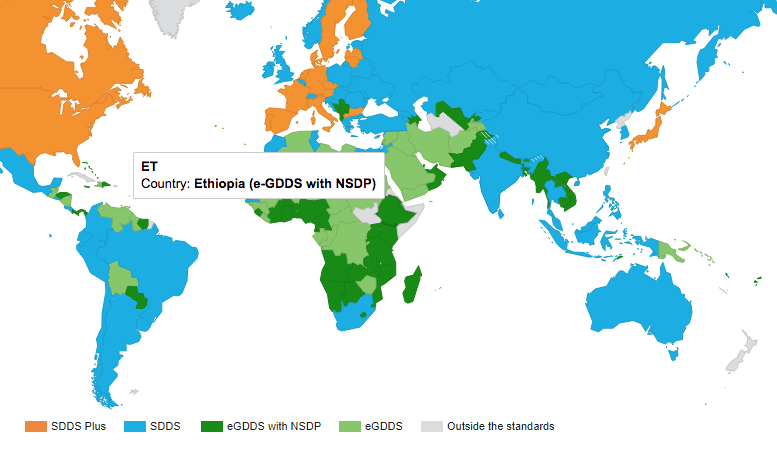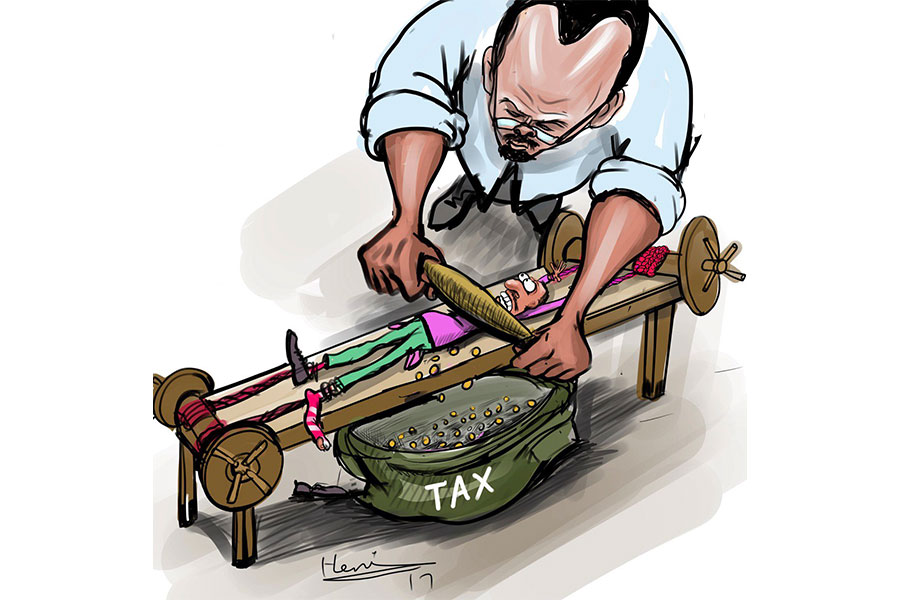
Editorial | Jan 01,2022
May 23 , 2020
By GELILA SAMUEL ( FORTUNE STAFF WRITER
)
The Ministry of Innovation & Technology tabled a digital economy strategy that is designed to lead the economy toward tech-led growth to the Council of Ministers for a final blessing.
The 157-page document was drafted in line with the Homegrown Economic Reform Agenda and the National 10-year Plan. It deliberates on the current bottlenecks limiting digitised operations, steps to be taken by the government and private sector to advance the digital economy, and expresses the country's need to embrace or leapfrog over global trends.
The strategy, titled the “Digital Strategy for Inclusive Prosperity 2025,” was in the making for the last year. It was reviewed by 11 development partners and civil society organisations, including the World Bank; 18 ministries and representative agencies; and 30 private sector representatives, start-ups and incubator leaders.
"We expect the Council to scrutinise the document and approve it next week," said Ahmedin Mohammed (PhD), state minister for Innovation & Technology.
The document has identified four pathways to pursuing digital growth in the modern economy: unleashing the value of agriculture, constructing the next version of the global value chain in manufacturing, building IT-enabled services, and focusing on digital as the driver of tourism competitiveness.
The pathways are dissected into three timelines of implementation: short-term, meaning one to three years; midterm, meaning eighteen months to three years; and long-term, meaning three to five years.
"There was a need for a breakdown of timelines this way to assess the progress of the project's goals," Ahmedin said.
Ethiopia is an agrarian country. Agriculture accounts for 45pc of GDP, 85pc of the country’s workforce, and 90pc of its export revenue. Recognising this, the strategy recommends building a digital agriculture platform: an integrated system that allows the use of new and advanced technologies integrated into one system to enable farmers and other stakeholders within the agriculture value chain to improve food and livestock production.
Second, to support and incentivise ag-tech entrepreneurship by identifying industry needs and market trends, government and businesses can incentivise the birth and growth of high-demand solutions. These are going to be implemented in a midterm timeframe, within 18 months to three years, according to the strategy.
The Ministry is already supporting ag-tech businesses to address some of the major challenges within the sector through the national business incubator programme as well as other associated initiatives.
There are around 12 ag-tech businesses under the Ministry, which are receiving guidance in product development, according to Ahmedin.
BlueMoon Ethiopia, which was one of the consultation members, is a committed incubator that invests in agriculture, livestock, fisheries and forestry.
The manufacturing sector is one of the sectors that is looking up for the country with 13 state-owned and private industrial parks. Many of these parks pursue apparel exports, including Hawassa, Meqelle, Kombolcha and Adama.
The Next Version of Global Value Chains in Manufacturing option suggests fast and reliable internet connectivity as a catalyst to enable the adoption of new communication technologies. It recommends Ethio ICT Village serve as the first prototype of experimentation with much more integrated services for manufacturing industries.
Logistics is one of the main hurdles to the success of the manufacturing industry with Ethiopia ranked 156 out of 190 countries on the World Bank’s Logistics Performance Index. Hence, the strategy outlines the need for the country to embrace trade logistics, in particular the interface between exports, digitalisation and trade logistics.
This is to be implemented through existing initiatives including Alibaba Group's electronic World Trade Platform, according to Ahmedin.
The Building the IT Enabled Services Sector option requires providing infrastructure to high potential talent centres, primarily made possible through online work in selected universities. This could also involve reframing and operationalising the IT parks to attract leading Business Processor Operators (BPOs), companies that handle the operations and responsibilities for a particular business process for a third-party service provider.
This is expected to be jump-started by connecting Ethio ICT Village to residential areas. The Village will serve as an initial BPO hub, and promoting an “always-on” policy for power and connectivity at the ICT Village could insulate export-oriented BPO companies from infrastructure challenges, according to Ahmedin.
Lastly, the Digital as the Driver of Tourism Competitiveness option is going to be driven through setting up a tourism digitisation task force to implement digital initiatives. The task force, which will be hosted by Tourism Ethiopia, is expected to be composed of the members from the ministries of Culture & Tourism and Innovation & Technology and other stakeholders.
The task force is expected to undertake launching pilots with a strong proof-of-concept to be able to raise investments and obtain appropriate resources to be scaled up. It is also expected to reduce the adverse effect of this risk, articulate objectives and clarify its evolving role in the ecosystem through a participatory workshop involving existing organisations to secure buy-in upfront.
The tourism sector in Ethiopia, which ranked 18th on tourism competitiveness among its East African counterparts such as Kenya, Tanzania and Rwanda, is also planning to leverage targeted digital marketing strategies. The approaches include social media, search engine optimisation, and digital payments that could improve Ethiopia’s image on the tourism map.
Infrastructure challenges, including power and connectivity, remain a challenge for the implementation of the strategy with 45pc and 44pc coverage, respectively.
More problematically, the internet and mobile data costs remain among the highest in the world. One gigabyte of monthly data in Ethiopia costs 51 dollars, compared to 25 dollars in Rwanda, 18 dollars in Ghana and Nigeria, and eight dollars in Kenya. Similarly, one gigabyte of data in Ethiopia costs 9.7pc of the per capita monthly income, while the International Telecommunication Union's recommended benchmark is two percent.
The strategy promotes working on initiatives that enable systems or platforms that allow remote verification and the creation of applications and services that ensure interoperability between them. This can be initiatives that include digital IDs, digital payment systems and cybersecurity.
In a country of almost 110 million inhabitants, banks are offering mobile wallet solutions to almost one million previously unbanked clients. Agent banking service providers such as MBirr and HelloCash have also been engaged, but these operators are still comparatively small. HelloCash has around one million customers and a network of 5,000 agents, while MBirr currently has some 1.2 million customers and a network of some 6,500 agents.
“We can see the government taking steps toward accepting the sector's needs,” said Zewdu Assefa, vice president of BelCash Technology. “Regardless, the sector needs a wider definition, for instance for trade license registrations.”
Ethiopia has not yet undergone a cybersecurity assessment, according to the strategy document.
“Without having done an assessment explicitly for Ethiopia," reads the document, "it's difficult to identify the most important vulnerabilities."
Understanding that there is a threat in the first place is the first step the government should take, according to Muluneh Baybel, an attorney currently studying business law at Addis Abeba University.
“And then designing the necessary legal frameworks and establishing an entity should follow,” said Muluneh. "This is a long-overdue approach."
Bureaucratic hurdles continue to act as bottlenecks to e-government and e-commerce services. Currently, out of all services provided by public offices, 175 of them are planned to be under e-gov. But so far only 70 services that are provided by 10 public offices are operational, and these services do not include a digital payment transaction option.
Inclusive eco-systems of finance, policy, regulation and awareness among people are also stumbling blocks. Recently, the government has passed laws governing e-transactions, including an agent banking directive and a payment license directive, as part of the effort to digitise operations and the need for an operating digital platform due to COVID-19.
PUBLISHED ON
May 23,2020 [ VOL
21 , NO
1047]

Editorial | Jan 01,2022

Radar | Apr 17,2021

Commentaries | Nov 27,2018

Fortune News | Nov 27,2018

Fortune News | Aug 03,2019

Viewpoints | May 14,2022

Viewpoints | Nov 02,2019

Radar | Dec 07,2019

Verbatim | Jun 14,2025

Featured | Aug 16,2020

Dec 22 , 2024 . By TIZITA SHEWAFERAW
Charged with transforming colossal state-owned enterprises into modern and competitiv...

Aug 18 , 2024 . By AKSAH ITALO
Although predictable Yonas Zerihun's job in the ride-hailing service is not immune to...

Jul 28 , 2024 . By TIZITA SHEWAFERAW
Unhabitual, perhaps too many, Samuel Gebreyohannes, 38, used to occasionally enjoy a couple of beers at breakfast. However, he recently swit...

Jul 13 , 2024 . By AKSAH ITALO
Investors who rely on tractors, trucks, and field vehicles for commuting, transporting commodities, and f...

Jul 26 , 2025
Teaching hospitals everywhere juggle three jobs at once: teaching, curing, and discov...

Jul 19 , 2025
Parliament is no stranger to frantic bursts of productivity. Even so, the vote last w...

Jul 12 , 2025
Political leaders and their policy advisors often promise great leaps forward, yet th...

Jul 5 , 2025
Six years ago, Ethiopia was the darling of international liberal commentators. A year...